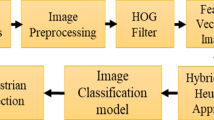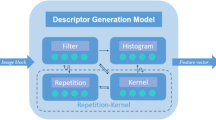Abstract
Pedestrian detection is a challenging task in computer vision, which is often treated as classification problem of pattern recognition. However, dealing with the high dimensional features extracted from images, it turns out to be difficult to choose and combine the informative features for classification. In this paper, a novel optimization method—Metropolis based Genetic Algorithm (MGA) is proposed to solve this problem, and a novel pedestrian detector MGA-SVM is presented and implemented. In MGA, the metropolis criterion is adopted into GA for dynamical parents’ selection, which makes the algorithm get a stronger ability to jump out of local minimum as well as achieve convergence. To test the effectiveness of the proposed MGA, we implement it for feature weight learning in SVM pedestrian detector, which is named as MGA-SVM. The experimental results demonstrate the MGA has a better optimization capacity than original GA, which leads to a more accurate pedestrian detection result by using MGA-SVM.











Similar content being viewed by others
References
Ahonen T, Hadid A, Pietikainen M (2006) Face description with local binary patterns: application to face recognition. IEEE Trans Pattern Anal Mach Intell 28(12):2037–2041
Benenson R, Mathias M, Tuytelaars T, Van Gool L (2013) Seeking the strongest rigid detector. In: Proceedings of the IEEE Computer Society Conference on Computer Vision and Pattern Recognition (CVPR), pp 3666–3673
Benenson R, Omran M, Hosang J, Schiele B (2014) Ten years of pedestrian detection, what have we learned? In: Computer Vision-ECCV 2014 Workshops, pp 613–627
Brank J, Grobelnik M, Mladenific D (2002) Feature selection using linear support vector machines. In: Proceedings of the third international conference on data mining methods and databases for engineering, finance and other fields
Dalal N, Triggs B (2005) Histograms of oriented gradients for human detection. In: 2005 I.E. Computer Society Conference on Computer Vision and Pattern Recognition (CVPR), pp 886–893
Dollar P, Tu Z, Perona P, Belongie S (2009) Integral channel features. In: BMVC 2009 London England, pp 1–11
Freeman W, Roth M (1995) Orientation histograms for hand gesture recognition. In: International Workshop on Automatic Face and Gesture Recognition, pp 296–301
Heikkila M, Pietikainen M, Schmid C (2009) Description of interest regions with local binary patterns. Pattern Recogn 42(3):425–436
Li Q, Zhou X, Gu A et al (2016) Nuclear norm regularized convolutional Max Pos@ Top machine. Neural Comput Appl 1–10
Liang RZ, Shi L, Wang H et al (2016) Optimizing top precision performance measure of content-based image retrieval by learning similarity function. In: International Conference on Pattern Recognition (ICPR), 2016 23st
Liang RZ, Xie W, Li W et al (2016) A novel transfer learning method based on common space mapping and weighted domain matching. In: 2016 I.E. 28th International Conference on Tools with Artificial Intelligence (ICTAI)
Liao S, Law MWK, Chung ACS (2009) Dominant local binary patterns for texture classification. IEEE Trans Image Process 18(5):1107–1118
Lu X, Gong T, Yan P et al (2012) Robust alternative minimization for matrix completion. IEEE Trans Syst Man Cybern B Cybern 42(3):939–949
Martinez AM, Kak AC (2001) Pca versus lda. IEEE Trans Pattern Anal Mach Intell 23(2):228–233
Mittal S, Prasad T, Saurabh S (2012) Pedestrian detection and tracking using deformable part models and Kalman filtering. In: 2012 International SoC Design Conference (ISOCC), pp 324–327
Mu Y, Yan S, Liu Y, Huang T, Zhou B (2008) Discriminative local binary patterns for human detection in personal album. In: 2008 I.E. Conference on Computer Vision and Pattern Recognition (CVPR), pp 1–8
Nguyen MH, de la Torre F (2010) Optimal feature selection for support vector machines. Pattern Recogn 43(3):584–591
Ojala T, Pietikainen M, Maenpaa T (2000) Gray scale and rotation invariant texture classification with local binary patterns. In: Computer Vision (ECCV), pp 1–35
Ouyang W, Wang X (2013) Joint deep learning for pedestrian detection. In: 2013 I.E. International Conference on Computer Vision (ICCV), pp 2056–2063
Qi B, Zhao C, Yin G (2014) Feature weighting algorithms for classification of hyper spectral images using a support vector machine. Appl Opt 53(13):2839–2846
Satpathy A, Jiang X, Eng H-L (2014) Lbp-based edge-texture features for object recognition. IEEE Trans Image Process 23(5):1953–1964
Sermanet P, Kavukcuoglu K, Chintala S, Lecun Y (2013) Pedestrian detection with unsupervised multi-stag feature learning. In: Proceedings of the IEEE Computer Society Conference on Computer Vision and Pattern Recognition (CVPR), pp 3626–3633
Silberstein S, Levi D, Kogan V, Gazit R (2014) Vision-based pedestrian detection for rear-view cameras. In: Intelligent Vehicles Symposium Proceedings, pp 853–860
Tao D, Cheng J, Song M et al (2016) Manifold ranking-based matrix factorization for saliency detection. IEEE Trans Neural Netw Learn Syst 27(6):1122–1134
Tao D, Guo Y, Song M et al (2016) Person re-identification by dual-regularized kiss metric learning. IEEE Trans Image Process 25(6):2726–2738
Tomar D, Agarwal S (2015) Hybrid feature selection based weighted least squares twin support vector machine approach for diagnosing breast cancer, hepatitis, and diabetes. Advances in Artificial Neural Systems 2015:1
Vondrick C, Khosla A, Malisiewicz T, Torralba A (2013) HOGgles: visualizing object detection features. In: Proceedings of the IEEE International Conference on Computer Vision (ICCV), pp 1–8
Wang T (2010) Improving SVM classification by feature weight learning. In: 2010 International Conference on Intelligent Computation Technology and Automation, ICICTA 2010, Vol 2(1), pp 518–521
Wang X, Han TX, Yan S (2009) An HOG-LBP human detector with partial occlusion handling. In: 2009 I.E. 12th International Conference on Computer Vision (ICCV), pp 32–39
Yang X, Zhang C, Tian Y (2012) Recognizing actions using depth motion maps-based histograms of oriented gradients. In: Proceedings of the 20th ACM international conference on Multimedia - MM ‘12, (c), pp 1057–1060
Zeng C, Ma H (2010) Robust head-shoulder detection by PCA-based multilevel HOG-LBP detector for people counting. In: International Conference on Pattern Recognition (ICPR), pp 2069–2072
Zhang S, Hossain M, Hassan M, Bailey J, Ramamohanarao K (2009) Feature weighted SVMs using receiver operating characteristics. In: Proceedings of the 2009 SIAM International Conference on Data Mining (SDM), pp 497–508
Zhang J, Huang K, Yu Y, Tan T (2011) Boosted local structured HOG-LBP for object localization. In: Proceedings of the IEEE Computer Society Conference on Computer Vision and Pattern Recognition (CVPR), pp 1393–1400
Zhang S, Benenson R, Schiele B (2015) Filtered channel features for pedestrian detection. In: Computer Vision and Pattern Recognition (CVPR), 2015 I.E. Conference on, pp 1751–1760
Author information
Authors and Affiliations
Corresponding author
Rights and permissions
About this article
Cite this article
Wei, X., Lu, W., Bao, P. et al. MGA for feature weight learning in SVM —a novel optimization method in pedestrian detection. Multimed Tools Appl 77, 9021–9037 (2018). https://doi.org/10.1007/s11042-017-4792-9
Received:
Revised:
Accepted:
Published:
Issue Date:
DOI: https://doi.org/10.1007/s11042-017-4792-9




